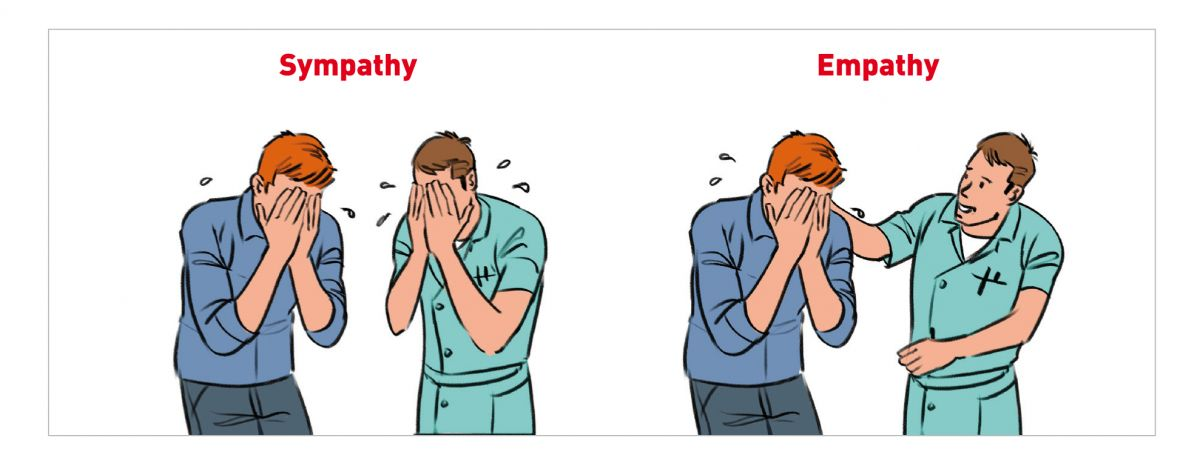Communication is a clinical skill (part 2)
Written by Miguel Ángel Díaz, Iván López Vásquez, Cindy Adams and Antje Blättner
One of the key skills in building relationships with others is the use of empathy. Empathy is referred to as the essential building block for extending compassion. That said, of all the skills used in a consultation, empathy is the one most often thought by learners to be a matter of personality trait rather than skill. Certainly one of the first steps in communicating empathy is the internal drive to truly want to understand the client’s perspective along with relevant communication skills to relay this knowingness. Although some of us are more naturally empathetic, skills necessary for empathy can be learned.
Article

Key Points
It’s not good enough to think empathetically. You must communicate it as well.
Empathy
Empathy requires the use of a 3-stage approach:
- Appreciating another person’s predicament or feelings by seeking to gather an understanding of their situation
- Communicating that understanding back to the person
- Pausing – coming to a full stop to let the other person absorb what has been said and give them the opportunity to say more or just feel your concern
Unlike sympathy that is more of a feeling of pity or concern outside of the client’s actual feelings or predicament, empathy is not only about being sensitive but overtly communicating that empathy to the client (Figure 1). It’s not good enough to think empathetically. You must communicate it as well. Use of empathy at appropriate times is a strong facilitative opening for clients to share more of their thoughts and concerns. This information is vital for understanding the client and working toward outcomes for the patients that take client’s concerns into consideration.

Empathetic statements are supportive comments that specifically link the “I” of the veterinarian and the “you” of the client. They both name and appreciate the client’s affect or situation. Verbal empathy is strengthened when accompanied by empathetic non-verbal communication, including facial expressions, proximity, touch, tone of voice, or use of silence.
Examples:
- “I can appreciate you were not anticipating the cost that it is going to take to get Riley back to his old self.”
- “I can hear that you are very excited to have a new puppy.”
- “I sense this is a frustrating situation for you.”
- “I can tell that you are very attached to Barney and you want what is best for him.”
It is not necessary to have shared the same experience as the client, nor do we need to feel that the situation would be difficult or evoke the same feelings for us. It is necessary to see the situation from the client’s perspective and communicate understanding back to the client.
“7% is the proportion of consultations where vets expressed empathy (study on 300 appointments).”
Building a relationship is vital to the success of every appointment and use of empathy is central to building the relationship. That said, research reveals that in 300 small animal visits (150 well animals, 150 sick animals) veterinarians expressed empathy in only 7% of appointments [1].
It is estimated that empathetic opportunities exist in the majority of appointments but they are largely overlooked. It has been shown that communication training with physicians made a significant difference in a physician’s empathetic expression during patient interactions 6 months after the training [2]. It’s clear that empathy can be taught, learned and integrated into clinical practice. Given the profound impact that empathy has on relationship development, it’s worth investing in.
References
- Shaw JR, Adams CL, Bonnett BN, Larson S, Roter DL. Use of the roter interaction analysis system to analyze veterinarian-client-patient communication in companion animal practice. JAVMA 2004;225(2):222-229.
- Bonvicini KA, Perlin MJ, Bylund CL, Carroll G, Rouse RA, Goldstein MG. Impact of communication training on physician expression of empathy in patient encounters. Patient Educ Couns 2009;75(1):3-10.
Miguel Ángel Díaz
DVM
Spain
Miguel received a degree in Veterinary Science in 1990. After working at several clinics he opened his own clinic in 1992 which grew from a two-person office to a 24/7 hospital with 17 employees. After running his hospital for 25 years, he handed it over to his team in 2017 in order to concentrate exclusively on his great passion: coaching.
Miguel is the director of the company New Way Coaching, aimed at helping veterinarians become better leaders. He has been educating and training veterinarians in Europe, Latin America, and Asia since 2009 in leadership, motivational techniques, effective communication, handling objections, conflict resolution, influence and persuasion. He spends his days giving individual coaching sessions, private training for his clients’ teams, and workshops and conferences for major veterinary sector companies.
Miguel is an International Coach Certified by the International Coaching Community and the Center for Executive Coaching (USA). He is a Certified Trainer for Edward de Bono’s Six Thinking Hats.
He has been an international speaker at conferences in over 10 countries on three continents. He is the author of the book “7 Keys to Successfully Running a Veterinary Practice”, which has been translated into English, Polish, Chinese and Italian.
Iván López Vásquez
DVM
Chile
Iván comes from a family of veterinarians; his father and older brother share the same passion. He obtained his degree from the Universidad de Concepción in 1991, worked a few years at a small clinic and then shifted his career towards sales and marketing, holding several positions at multinational companies in the domestic pet market in his native country.
Since 2008 he has been the executive director of Vetcoach, a business and organizational consulting company that specializes in the pet veterinary sector in Latin America, where his vision is to create “a new standard for the veterinary world”.
Iván has studied marketing, innovation, coaching and positive psychology. Today he is a strategic business consultant in organizational development and innovation, an ORA Coach (Organizational Role Analysis), creator of initiatives to improve the well-being (happiness) of veterinary students and qualified veterinarians, as well as high-value training programs for veterinary companies and their teams on subjects such as management, wellbeing, communication skills and positive leadership.
Iván has written several management articles for veterinary journals and is an international conference speaker in Latin America.
Cindy Adams
MSW, PhD
Canada
Cindy Adams is Professor in the Department of Veterinary Clinical and Diagnostic Sciences at the University of Calgary, Veterinary Medicine, where she developed and implemented the Clinical Communication Program in Calgary’s new veterinary school. She honed her professional understanding of human-animal relationships serving from 1980-1992 as a social worker in child welfare, women’s shelters and the justice system. Animals were frequently involved in that work. Combining the very different perspectives gained from her experiences in social work and a doctorate in veterinary epidemiology, she became a faculty member at the Ontario Veterinary College, University of Guelph (1996-2006). There she designed and directed the first veterinary communication curriculum in North America and pioneered a research program regarding communication in veterinary medicine.
She helped initiate the Institute for Healthcare Communication, Bayer veterinary communication project. Her research has focused on communication education, veterinary-client communication in large and small animal contexts, animal welfare, companion animal death and human grief. Founder of the International Conference on Communication in Veterinary Medicine, co-author of Skills for Communicating in Veterinary Medicine she has presented widely and advised veterinarians, veterinary practice teams and veterinary educators throughout North America, Europe, Australia and the Caribbean.
Antje Blättner
DVM
Germany
Dr. Blaettner grew up in South Africa and Germany and graduated in 1988 after studying Veterinary Medicine in Berlin and Munich. She started and ran her own small animal practice before undertaking postgraduate training and coaching course at the University of Linz, Austria and then founded “Vetkom”. The company provides training to veterinarians and veterinary nurses in practice management in subjects such as customer communication, marketing and other management topics. Dr. Blaettner also is editor for two professional journals, “Teamkonkret” (for veterinary nurses) and “Veterinärspiegel” (for veterinarians).
Other articles in this issue
Share on social media